
The evergreen bagworm, commonly known as bagworm, eastern bagworm, common bagworm, common basket worm, or North American bagworm, is a moth that spins its cocoon in its larval life, decorating it with bits of plant material from the trees on which it feeds.

The black and yellow mud dauber, Sceliphron caementarium, is a species of sphecid wasp. There are some 30 other species of Sceliphron that occur throughout the world, though in appearance and habits they are quite similar to S. caementarium.

Wasps in the family Pompilidae are commonly called spider wasps, spider-hunting wasps, or pompilid wasps. The family is cosmopolitan, with some 5,000 species in six subfamilies. Nearly all species are solitary, and most capture and paralyze prey, though members of the subfamily Ceropalinae are kleptoparasites of other pompilids, or ectoparasitoids of living spiders.
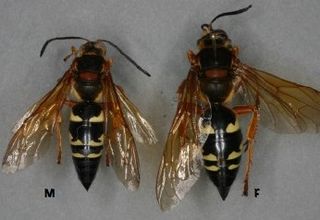
Sphecius speciosus, often simply referred to as the cicada killer or the cicada hawk, is a large digger wasp species. Cicada killers are large, solitary wasps in the family Crabronidae. The name may be applied to any species of crabronid which preys on cicadas, though in North America it is typically applied to a single species, S. speciosus. However, since there are multiple species of related wasps, it is more appropriate to call it the eastern cicada killer. This species occurs in the eastern and midwest U.S. and southwards into Mexico and Central America. They are so named because they hunt cicadas and provision their nests with them. In North America they are sometimes called sand hornets, although they are not hornets, which belong to the family Vespidae. Cicada killers exert a measure of natural control on cicada populations and thus may directly benefit the deciduous trees upon which their cicada feed.
Hymenoepimecis argyraphaga is a Costa Rican parasitoid wasp whose host is the spider Plesiometa argyra. The wasp is unusual in modifying the spider's web building behavior to make a web made of very strong lines designed to support the wasp's cocoon without breaking in the rain.
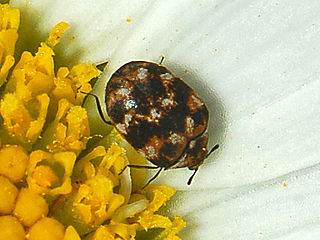
The varied carpet beetle is a 3 mm-long beetle belonging to the family Dermestidae. They are a common species, often considered a pest of domestic houses and, particularly, natural history museums, where the larvae may damage natural fibers and can damage carpets, furniture, clothing, and insect collections. A. verbasci was also the first insect to be shown to have an annual behavioral rhythm and to date remains a classic example of circannual cycles in animals.
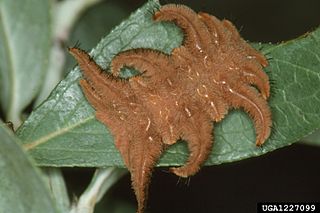
Phobetron pithecium, the hag moth, is a moth of the family Limacodidae. Its larva is known as the monkey slug.
The wattle bagworm is a species of moth in the family Psychidae. In southern Africa it is a pest of the black wattle which is grown largely as a source of vegetable tannin. Kotochalia junodi is indigenous to Southern Africa, where it originally fed on indigenous relatives of the wattle.

The emerald cockroach wasp or jewel wasp is a solitary wasp of the family Ampulicidae. It is known for its unusual reproductive behavior, which involves stinging a cockroach and using it as a host for its larvae. It thus belongs to the entomophagous parasites.

Philanthus triangulum, commonly known as the European beewolf, bee-killer wasp or the bee-eating philanthus, is a solitary wasp that lives in the Western Palearctic and Afrotropics. Although the adults of the species are herbivores, the species derives its name from the behaviour of the inseminated females, who hunt Western honey bees. The female places several of its paralysed prey together with an egg in a small underground chamber, to serve as food for the wasp larvae. All members of the genus Philanthus hunt various species of bees, but P. triangulum is apparently the only one that specialises in Western honey bees.

Dryinidae is a cosmopolitan family of solitary wasps. Its name comes from the Greek drys for oak: Latreille named the type genus Dryinus because the first species was collected in an oak plant in Spain. The larvae are parasitoids of the nymphs and adults of Auchenorrhyncha. Dryinidae comprises approximately 1900 described species, distributed in 17 subfamilies and 53 genera.

Cotinis nitida, commonly known as the green June beetle, June bug or June beetle, is a beetle of the family Scarabaeidae. It is found in the eastern United States and Canada, where it is most abundant in the South. It is sometimes confused with the related southwestern species figeater beetle Cotinis mutabilis, which is less destructive.
Dinocampus coccinellae is a braconid wasp parasite of coccinellid beetles, including the spotted lady beetle, Coleomegilla maculata. D. coccinellae has been described as turning its ladybird host into a temporary "zombie" guarding the wasp cocoon. About 25% of Coleomegilla maculata recover after the cocoon they are guarding matures, although the proportion of other ladybird species which recover is much lower.
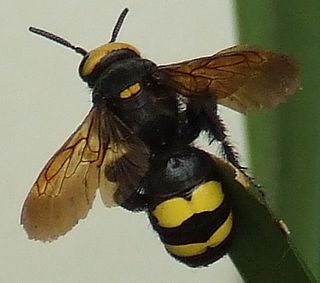
The mammoth wasp is a very large wasp, with the female reaching up to 6 centimetres (2.4 in), whereas the male is smaller. The species can be seen in warm weather, from May to September.

Sceliphron laetum is a wasp in the family Sphecidae, the mud-dauber wasps. Like other members of this genus, it is a solitary species and builds cells out of mud in which to rear its young, provisioning them with paralysed spiders, and laying an egg in each. This wasp is native to Australia and southeastern Asia.

Hypera postica, commonly known as the alfalfa weevil, is a species of beetle in the superfamily Curculionoidea; it can be found in alfalfa fields throughout Europe. Considered a destructive threat to alfalfa production in North America, several accidental introductions have been successfully countered though the use of a variety of biological control species.

Pison spinolae, commonly known as mason wasp, is a solitary wasp of the family Crabronidae, found throughout New Zealand.
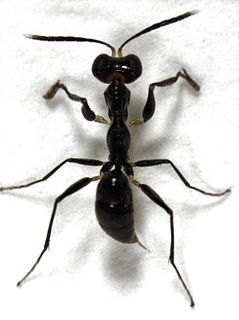
Gonatopus is a genus of solitary wasps of the family Dryinidae, sometimes called hump-backed pincer wasps. The wingless females have large scissor-like appendages at the tips of the front legs which are used to catch the leafhopper grubs which act as hosts to the larvae of these wasps. The larva consumes the leafhopper grub from the inside. An indication that a leafhopper is hosting a grub is a cyst of accumulated shed integuments which surround and protect the growing wasp larva.

Zatypota percontatoria is a species of parasitoid wasps that is part of the order Hymenoptera and the family Ichneumonidae responsible for parasitizing arachnids, specifically those of the family Theridiidae.

Mantispa styriaca, the Styrian praying lacewing, is a species of predatory mantidfly native to Europe. It is a yellow-brown insect as an adult and has multiple larval stages.
















